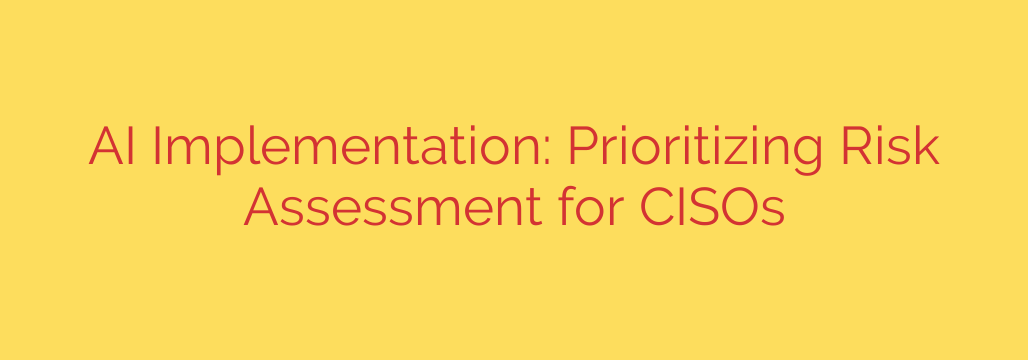
Navigating the AI Frontier: A CISO’s Guide to Proactive Risk Assessment
The rapid integration of Artificial Intelligence is no longer a future concept—it’s a present-day reality transforming business operations. From generative AI creating content to machine learning models optimizing supply chains, AI offers unprecedented opportunities for innovation and efficiency. However, for Chief Information Security Officers (CISOs), this new frontier presents a complex and evolving threat landscape.
Simply reacting to AI-related security incidents is not a viable strategy. Instead, security leaders must adopt a proactive, risk-first approach to ensure that AI is implemented safely, responsibly, and securely. Balancing the drive for innovation with the imperative of security is the CISO’s core challenge in the age of AI.
The New Generation of AI-Driven Risks
Traditional security frameworks are not fully equipped to handle the unique vulnerabilities introduced by AI systems. The attack surface has expanded, introducing risks that are fundamentally different from those seen before. Security leaders must be aware of these new threats to build an effective defense.
Key concerns include:
- Shadow AI: Just as “shadow IT” became a major concern, employees are now independently using unsanctioned AI tools for work-related tasks. This creates a massive blind spot, as sensitive corporate data may be fed into third-party models without any security oversight.
- Data Poisoning: Malicious actors can intentionally feed bad data into a machine learning model during its training phase. This can corrupt the model’s logic, leading it to make incorrect decisions, exhibit biases, or create backdoors for future exploitation.
- Model Inversion and Data Leakage: Sophisticated attacks can reverse-engineer an AI model to extract the sensitive, private, or proprietary data it was trained on. This poses a significant risk to customer privacy and corporate intellectual property.
- Prompt Injection: Attackers can craft malicious inputs (prompts) to trick generative AI models into bypassing their safety controls, revealing confidential information, or executing unintended commands.
A Strategic Framework for AI Risk Assessment
To navigate this complex environment, CISOs must establish a robust AI governance and risk assessment framework. This isn’t about stopping innovation; it’s about enabling it securely. Here is a step-by-step approach to building that foundation.
1. Gain Full Visibility and Map Your AI Landscape
Before you can secure your AI implementations, you must know what they are and where they live. The first step is to conduct a comprehensive inventory of all AI and machine learning systems in use across the organization, whether developed in-house, purchased from a vendor, or used freely by employees. You cannot protect what you don’t know exists. This discovery process is critical for identifying unsanctioned “shadow AI” tools and understanding the full scope of your risk exposure.
2. Prioritize Data Governance and Classification
AI models are powered by data, making data governance more critical than ever. It is essential to understand what kind of data is being used to train and operate each AI model. A strong data classification policy will help you identify and protect sensitive information, including personally identifiable information (PII), intellectual property, and financial data. Treat data as the crown jewels of your AI strategy, ensuring that models only have access to the information they absolutely need.
3. Conduct AI-Specific Threat Modeling
Your existing threat modeling processes need an upgrade. It’s time to analyze your AI systems through the lens of a modern attacker. Ask critical questions: Could this model be poisoned with bad data? What is the risk of a prompt injection attack? How could an adversary extract the training data? Adapt your threat modeling to think like an AI-era attacker, focusing on the entire AI lifecycle, from data collection to model deployment and monitoring.
4. Establish Clear AI Usage Policies and Guardrails
Employees need clear rules of the road for using AI tools. Develop and communicate a formal Acceptable Use Policy (AUP) for AI that specifies which tools are approved, what types of data are permissible to use as inputs, and how to handle AI-generated outputs. Clear policies are the guardrails that prevent innovation from driving off a cliff. Consider creating a centralized AI Center of Excellence to provide guidance, vet new tools, and promote best practices across the organization.
5. Implement Continuous Monitoring and Incident Response
AI systems are not static. They evolve as they process new data, and the threat landscape changes just as quickly. Implement continuous monitoring solutions to detect anomalous behavior in your AI models, such as unexpected outputs or unusual data access patterns. Your incident response plan should also be updated to include scenarios specific to AI, ensuring your team is prepared to handle a data poisoning or model theft incident. AI security is not a one-time setup; it is a continuous cycle of monitoring and adaptation.
From Gatekeeper to Strategic Enabler
The CISO’s role in the era of AI is evolving from a technology gatekeeper to a strategic business enabler. By embedding security into the AI lifecycle from the very beginning, you can build trust, mitigate risk, and empower your organization to leverage this transformative technology with confidence. A proactive risk assessment strategy is the key to unlocking the full potential of AI while safeguarding the enterprise against the threats of tomorrow.
Source: https://www.helpnetsecurity.com/2025/08/21/cloud-ai-security-readiness-2025/








